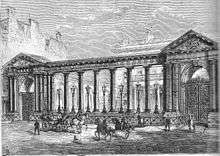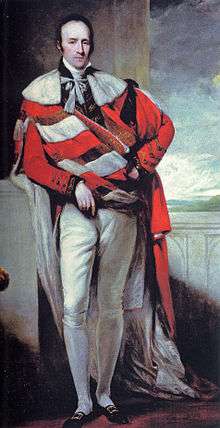Grosvenor House
Coordinates: 51°30′35.2″N 0°9′19.7″W / 51.509778°N 0.155472°W

Grosvenor House was one of the largest private townhouses situated on Park Lane in London. The house was the home of the Grosvenor family (better known as the Dukes of Westminster) for more than a century. Their original London dwelling was on Millbank but, after the family had developed their Mayfair estates, they moved to Park Lane to build a house worthy of their wealth, status and influence in the 19th century.
Brief history


The site was occupied by a small house named 'Gloucester House' (after Prince William Henry, Duke of Gloucester and Edinburgh (d. 1805) who owned it) with the front entrance on Upper Grosvenor Street. This house was purchased by Robert Grosvenor, 1st Marquess of Westminster (d. 1845) in 1805 for £20,000. He spent £17,000 on extending the house to make it more fashionable with the times. In 1821, a large picture gallery 50 feet (15 m) long was added to the west of the house. It was in here that many of the Grosvenor treasures were held.
Another extension was added in 1842, in the form of a 110 feet (34 m) long classical-style colonnaded entrance screen on Upper Grosvenor Street. At each end was a triumphal arch with pediments above sculpted with the Grosvenor arms. Thomas Cundy, the architect of this vast house then proposed a larger mansion to go all the way along to Park Street extending all the way to 230 feet (70 m). This was dropped as the 2nd Marquess thought it was to be too lavish.
In 1870 Hugh Grosvenor, 3rd Marquess of Westminster (d. 1899) (later the 1st Duke) commissioned Henry Clutton to add a Porte-Cochére to the north and had many of the state rooms redesigned. In 1889 electricity was introduced, being one of the first buildings in London to do so.
Demolition
The house was in the Grosvenors' possession until the First World War, at which point the government requisitioned it. After the war, the family decided it was too lavish to maintain and it was sold. The house was demolished and the Grosvenor House Hotel built on the site. The Grosvenor House is the first JW Marriott Hotel Brand in the United Kingdom.
The Grosvenor hotel - the venue for some of London's grandest award ceremonies - was sold to Indian conglomerate Sahara for £470m in December 2010.[1]
The new owner, Sahara India Pariwar, said it planned to manage the hotel on a joint basis with Marriott.
Art collections
It is said that the house housed one of the best private art collections in the world with paintings by Gainsborough, Velázquez and other old masters. Some of these were sold between the wars but most remain in the other Grosvenor homes, mainly their country seat - Eaton Hall in Cheshire.
Notes
- ↑ Russell, Johnathan (31 December 2010). "Sahara buys Grosvenor House Hotel from RBS for £470m". telegraph.co.uk. Retrieved 9 April 2012.
Sources
- Walford, Edward. Old & New London: A Narrative of Its History, Its People & Its Places, 6 vols., London, 1881, vol 4, pp. 370–372.